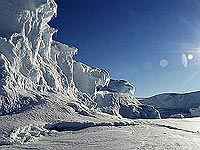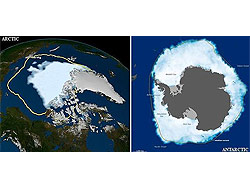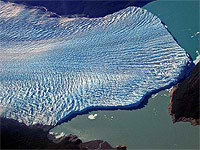Después de recabar datos sobre los procesos de deshielo más recientes en el Polo Norte, hace 9.000 y 7.600 años, los científicos temen que el crecimiento del nivel del mar como consecuencia del cambio climático sea mayor del estimado.
En un artículo publicado en la revista británica "Nature Geoscience", investigadores de la Universidad de Wisconsin (EEUU) explican las causas y consecuencias de la rápida fusión de las enormes capas de hielo de Laurentide, una región helada situada en el actual Canadá y el norte de Estados Unidos.
La causa de este rápido deshielo, que se produjo en dos periodos al principio del Holoceno -actual época del cuaternario, que empezó hace más de 11.700 años-, fue el incremento de las temperaturas de verano y de la radiación solar.
La fusión de esta gran masa de hielo en dos periodos separados por 1.400 años, hizo que el nivel del mar aumentara 0,7 y 1,3 centímetros por año en uno y otro proceso.
El equipo investigador liderado por Anders Carlson llegó a estas conclusiones tras hacer una reconstrucción de estos deshielos a partir de evidencias marinas y terrestres.
Noticia completa en Heraldo (España)
Enlaces a sitios |
| |
Climbing Magazine Climbing Magazine"s Web site contains more than 30 years of rock and ice climbing news, climber profiles, technical information, and gear reviews. You"ll also find message boards, photo galleries, and classifieds
| Cold Regions Bibliography Between 1999 and 2000, this project was carried out under an Interagency Agreement between the Federal Research Division of the Library of Congress and the U.S. Army Cold Regions Research and Engineering Laboratory (CRREL).
|
Descent into the Ice A tem of "glacionauts" ventures into a labyrinth of unexplored anda hazardous glacier caves on France"s Mont Blanc
| Glacier and Permafrost Hazards in Mountains – GAPHAZ Scientific Working Group of the International Association of Cryospheric Sciences (IACS) and the International Permafrost Association (IPA). Department of Geosciences University of Oslo
|
Glacier hazards The experience and data on glacier disasters in Switzerland has been systematically collected in the past two decades, and historical sources were analyzed.
| Glacier Hazards From Space Glacier hazards represent a continuous threat to human lives and infrastructure in mountain regions.
|
Glacier Hazards in Perú The floods, known in Perú as aluviónes, come with little or no warning and are composed of liquid mud that generally transports large rock boulders and blocks of ice.
| Glaciers and Glacier Hazards Glaciers and Glacier Hazards Glaciers and Ice Sheets and Volcanic Eruptions, USGS/Cascades Volcano Observatory, Vancouver, Washington
|
Glaciers online Glaciers online offers photos and summary explanations concerning glaciers from all over the world. The primary goal of our project is to enrich and stimulate the teaching of Earth Science and Physical Geography, in particular glaciology.. Jürg Alean & Mi
| Global Land Ice Measurements from Space GLIMS (Global Land Ice Measurements from Space) is a project designed to monitor the world"s glaciers primarily using data from optical satellite instruments, such as ASTER (Advanced Spaceborne Thermal Emission and reflection Radiometer).
|











 Imagen: Agencias / Internet
Imagen: Agencias / Internet





